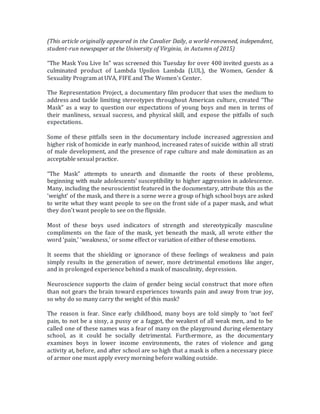Melden
Teilen

Empfohlen
This study analizes the harmful effects of bullfighting on children and youth educationDoes bullfighting represent a psychological danger for young spectators ?

Does bullfighting represent a psychological danger for young spectators ?Plataforma La Tortura No Es Cultura
Weitere ähnliche Inhalte
Ähnlich wie The Mask You Live In
This study analizes the harmful effects of bullfighting on children and youth educationDoes bullfighting represent a psychological danger for young spectators ?

Does bullfighting represent a psychological danger for young spectators ?Plataforma La Tortura No Es Cultura
Ähnlich wie The Mask You Live In (11)
Tou h Guise – Violence, Media & the Crisis in Masculinit .docx

Tou h Guise – Violence, Media & the Crisis in Masculinit .docx
Toxic MasculinityJaclyn FriedmanMarch 13, 2013httpprospec.docx

Toxic MasculinityJaclyn FriedmanMarch 13, 2013httpprospec.docx
Does bullfighting represent a psychological danger for young spectators ?

Does bullfighting represent a psychological danger for young spectators ?
Tasers, Abortion and Parenting: Behind the Curtain of Policing America

Tasers, Abortion and Parenting: Behind the Curtain of Policing America
This discussion is about the film Sex The movie Answer.docx

This discussion is about the film Sex The movie Answer.docx
The Mask You Live In
- 1. (This article originally appeared in the Cavalier Daily, a world-renowned, independent, student-run newspaper at the University of Virginia, in Autumn of 2015) “The Mask You Live In” was screened this Tuesday for over 400 invited guests as a culminated product of Lambda Upsilon Lambda (LUL), the Women, Gender & Sexuality Program at UVA, FIFE and The Women's Center. The Representation Project, a documentary film producer that uses the medium to address and tackle limiting stereotypes throughout American culture, created “The Mask” as a way to question our expectations of young boys and men in terms of their manliness, sexual success, and physical skill, and expose the pitfalls of such expectations. Some of these pitfalls seen in the documentary include increased aggression and higher risk of homicide in early manhood, increased rates of suicide within all strati of male development, and the presence of rape culture and male domination as an acceptable sexual practice. “The Mask” attempts to unearth and dismantle the roots of these problems, beginning with male adolescents’ susceptibility to higher aggression in adolescence. Many, including the neuroscientist featured in the documentary, attribute this as the ‘weight’ of the mask, and there is a scene were a group of high school boys are asked to write what they want people to see on the front side of a paper mask, and what they don’t want people to see on the flipside. Most of these boys used indicators of strength and stereotypically masculine compliments on the face of the mask, yet beneath the mask, all wrote either the word ‘pain,’ ‘weakness,’ or some effect or variation of either of these emotions. It seems that the shielding or ignorance of these feelings of weakness and pain simply results in the generation of newer, more detrimental emotions like anger, and in prolonged experience behind a mask of masculinity, depression. Neuroscience supports the claim of gender being social construct that more often than not gears the brain toward experiences towards pain and away from true joy, so why do so many carry the weight of this mask? The reason is fear. Since early childhood, many boys are told simply to ‘not feel’ pain, to not be a sissy, a pussy or a faggot, the weakest of all weak men, and to be called one of these names was a fear of many on the playground during elementary school, as it could be socially detrimental. Furthermore, as the documentary examines boys in lower income environments, the rates of violence and gang activity at, before, and after school are so high that a mask is often a necessary piece of armor one must apply every morning before walking outside.
- 2. “The Mask You Live In” also addresses fraternity and college sports teams’ increased rates of alcohol and drug consumption, marking this as an indicator of the high threshold of emotional blockage due to the mask that must be overcome by mind- altering substances in order for many men to truly connect. This documentary also connects male emotional blockage caused by stereotypical masculinity to increased violence towards women, perpetuated by masses of online pornography that depicts men as their sexual conquerors. A memorable statistic from the film indicated that 18% of boys had seen the act of rape online before turning 18 through some form of pornography, and it is these depictions that affirm male violence towards women, which is at epidemic proportion in the United States. Once the film ended and discussion began, many wondered “what can we do to help or fix this problem?” A popular answer was to call men out as often as possible for unacceptable, stereotypically masculine behavior, but a less confrontational yet related solution is for all of us to individually shed the masks we wear everyday as examples. Masculinity is just one type of mask among many that humans wear to pass through society without being rejected by our peers and those we wish to impress, but as we can see through this documentary, the weight of the mask is heavier than the benefit of wearing it. article by Arts & Entertainment writer Frederic R. Lee